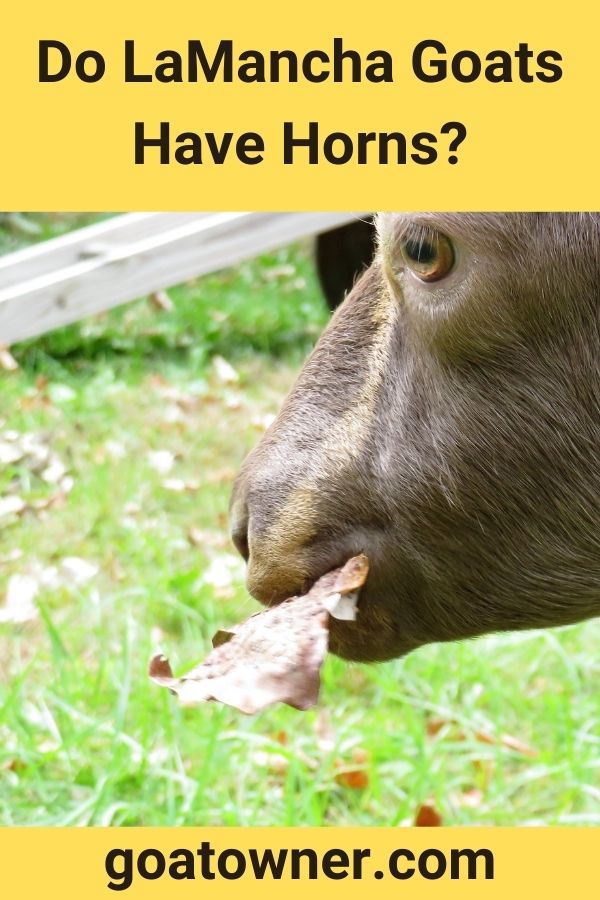I was out at a goat auction with my son the other day, and he pulled me over to one particular pen that he wanted me to see.
There were some kinds of goats in there that he’d never seen before, he said, and they looked almost like alien goats, apparently.
I was really intrigued by what he’d seen, so I followed him to see these alien goats. What he showed me, as I explained when we reached them, were LaMancha goats. He was amazed by their little ears, and asked me about their lack of horns.
So, do LaMancha goats have horns?
LaMancha goats are, pretty much without exception, disbudded at around two weeks old. This means their horns are prevented from growing—but they certainly can grow large, round, impressive horns like bighorn sheep. Naturally, they do have horns, they’re typically just removed.
Because the horns can grow so large and unruly, can even cover the eyes and even be a problem in a non-aggressive goat, they are typically prevented from growing.
LaMancha goats are most often used as dairy goats, so the lack of horns makes them much easier to manage.
Let’s look further into this.
Are LaMancha goats naturally polled?
Firstly, let’s just look at what we mean by polled.
In breeding, a goat having polled genetics means that it is naturally hornless.
This means that the goat will have no horns, regardless of what is done to it after its birth and development.
In general, as a whole, LaMancha goats are not naturally polled.
Most of them do indeed have horns that grow in, just like any other goat.
For reasons I will get into, these horns are almost always removed before they have the chance to mature, but they are there.
Goat pedigrees are enormous in variety, though, and the LaMancha in particular has been registered with goat breeding registries since 1958.
Even since that time, there have been breed lines that are naturally polled.
The horns need not be removed.
However, there are many more that are not naturally polled.
As I said, LaMancha goats have huge horns, and so there has been a widespread effort for decades, perhaps centuries, to get them to this point.
Let’s look at exactly why this is.
Why are LaMancha goats hornless?
Again, just to be clear, the basic, essential reason that they usually don’t have horns is because the development of those horns was artificially curtailed by humans.
LaMancha goats are hornless individuals because we make them that way.
The reasons for this are varied.
As I said, a LaMancha goat that is not debudded or naturally polled will grow enormous and impressive horns that often circle around multiple times in front of its face.
This makes the goat’s life, in general, quite a bit more difficult.
It also can make life more difficult for the person rearing them.
Very large horns are dangerous, to say the least, even on a completely docile goat.
A jerk reaction could easily send their head and horns flying towards you.
The most common reason for breeding LaMancha goats is as dairy goats.
So, as opposed to meat goats, LaMancha goats will need to be handled a great deal, as much as twice daily, by their owners.
This leaves a lot of room for injury if the goat has great big horns.
So, biologically speaking, goats are hornless because we do our best to make them that way.
Practically speaking, they’re hornless because it makes it easier to deal with them when milking.
So, how can you tell a LaMancha goat, if not by its horns?
How can you tell a LaMancha goat?
LaMancha goats, even without their horns, are very distinctive.
Indeed, they are often so distinctive because they are hornless, and their features are easy to recognize within that context.
The first and most recognizable feature people often turn to is their ear pinnae.
Compared with other goats, LaMancha goats have very short ears, jutting out to one side of their face by only an inch or two.
If they have kept their horns, these are also extremely recognizable.
Most of the time, they will simply curl out in a long curve behind the head—though they can, as I said, also spin around and spiral in front of the face.
The ears, though, are the main way to identify a LaMancha goat.
Are LaMancha goats friendly?
Yes, they really are very friendly.
They are known for their easy-going temperament, and though they have been primarily bred due to their extremely high milk yield, they are also very popular as pets and companions, too.
Naturally, though, this will depend on the individual.
Goats have much more complex personalities than we might imagine, and so there can be a lot of variation from one goat to the next.
Males can be boisterous and aggressive if not neutered at a young age, and this can be especially problematic with very large horns.
If you keep that in mind, your LaMancha goats should be very friendly.
So, while there is a degree of natural polling in many LaMancha pedigrees, the fact is that they are most often naturally disbudded at a young age.
The horns of a LaMancha are simply too much to deal with, make milking much harder.
Disbudding the goat has little effect on their well-being, as long as the males are neutered, too.
LaMancha goats do, naturally, have horns, but they are simply removed by human agency to make farming them easier.

